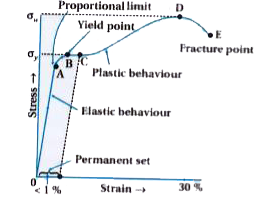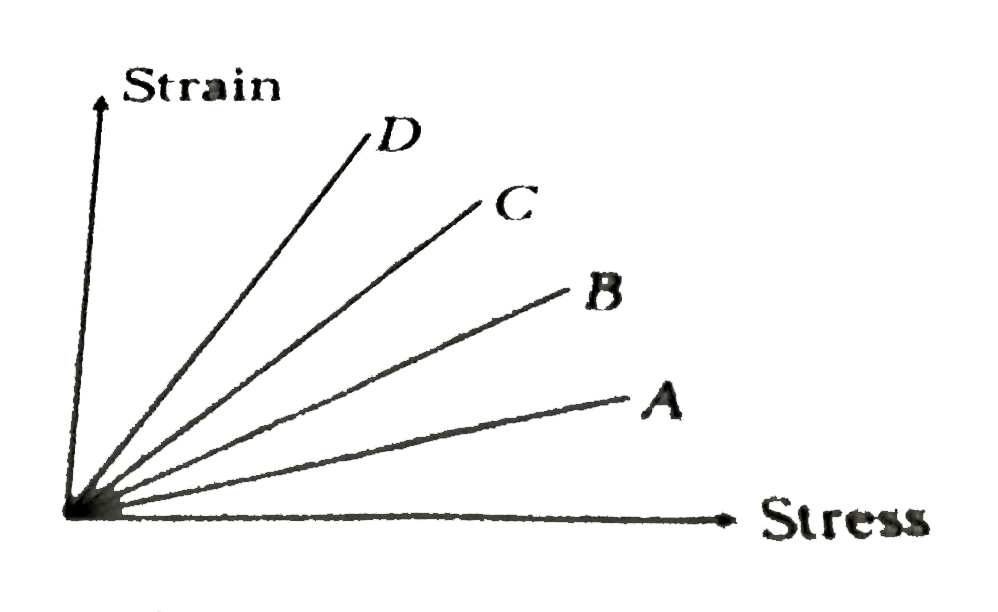Plot a stress → strain curve for a metal and explain.Solution in Gujrati
A stress → strain curve for a metal is shown as in figure.
From the graph, we can see that in the region between 0 to A, the curve is linear. In this region Hooke.s law is obeyed.
The body regains its original dimensions when the applied force is removed. In this region the solid behaves as an elastic body.

In the region from A to B stress and strain are not proportional. The body still returns to its original dimension when the load is removed. The point B in the curve is known as yield point (also known as elastic limit) and the corresponding stress is known as yield strength (σy) of the material.
If the load is increased further, from point B the stress developed exceeds the yield strength and strain increases rapidly.
The portion of the curve between B and D shows this, when the load is removed say at some point C between B and D, the body does not regain its original dimension.
In this state, even when the stress is zero, the strain is not zero. The material is said to have a permanent set. The deformation is said to be plastic deformation. The point D on the curve isthe ultimate tensile strength (σu) of the material. Beyond this point, additional strain is produced even by a reduced applied force and fracture occurs at point E.
If the ultimate strength and fracture points D and E are close, the material is said to be brittle. If they are far apart, the material is said to be ductile.
Topper's Solved these Questions
- BOOK - KUMAR PRAKASHANCHAPTER - MACHANICAL PROPERTIES OF SOLIDS EXERCISE - SECTION-A TRY YOURSELF (VSQs)40videos
MACHANICAL PROPERTIES OF SOLIDS
- BOOK - KUMAR PRAKASHANCHAPTER - MACHANICAL PROPERTIES OF SOLIDS EXERCISE - SECTION-B45videos
MACHANICAL PROPERTIES OF SOLIDS
- BOOK - KUMAR PRAKASHANCHAPTER - LAW OF MOTIONEXERCISE - (QUESTION PAPER) SECTION-D1videos
LAW OF MOTION
- BOOK - KUMAR PRAKASHANCHAPTER - MECHANICAL PROPERTIES OF FLUIDS EXERCISE - QUESTION PAPER (SECTION -C)3videos
MECHANICAL PROPERTIES OF FLUIDS
Similar Questions
What are solid bodies composed ?
00:52View SolutionA structural steel rod has a radius of 10 mm and a length of 1.0 m. A 100 KN force stretches it along its length. Calculate a stress, (b) elongation and (c) strain on the rod. Young's modulus of structural steel is2.0×1011Nm−2.
01:09View SolutionA 70 kg man stands in contact against the inner wall of a hollow cylindrical drum of radius 3 m rotating about its vertical axis with 200 rev/min. The coefficient of friction between the wall and his clothing is 0.15. What is the minimum rotational speed of the cylinder to enable the man to remain stuck to the wall (without falling) when the floor is suddenly removed ?
07:27View SolutionGlycerine flows steadily through a horizontal tube of length 1.5m and radius 1.0 cm . If the amount of glycerine collected per second at one is 4.0×10−3kgs−1 , what is the pressure difference between the two ends of the tube ? (Density of glycerine =1.3×10103kgm−3 and viscosity of glycerine =0.83 Pa s). [ you may also like to check if the assumption of laminar flow in the tube is correct]
46:01View SolutionThe graph given is a stress-strain curve for
 51:45View Solution
51:45View SolutionStress-strain curve for four metals are shown in figure. The maximum Young's modulus of elasticity is for metal
 49:01View Solution
49:01View SolutionWrite stress-strain curve for a metal. What is proportional limit and yield point ?
21:18View SolutionStress And Strain|Hookes Law#!#Stress Strain Curve
05:02View SolutionStress Strain Curve|Elastic Moduli
03:19View SolutionHooke's Law|Stress-Strain Curve
42:25View SolutionStress-Strain Curve|Problems On Hooke's Law
06:42View SolutionExplain hydraulic stress, volume stress and volume strain
01:49View SolutionWhat is an elastomer's ? Plot stress → strain curve for it and explain.
02:47View SolutionStress-strain curve| Hooke law and Elastic Moduli
04:31View SolutionExplain the stress-strain curve with an appropriate graph.
01:44:36View Solution

